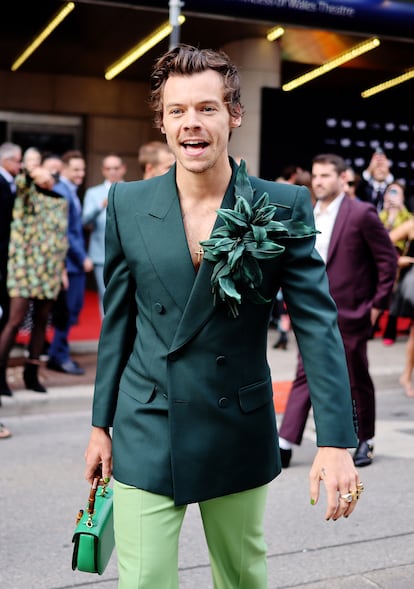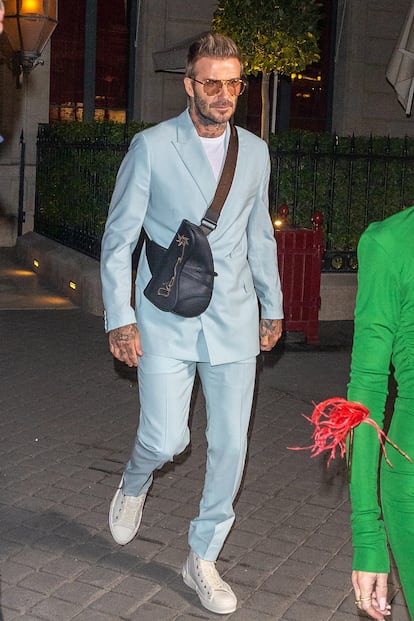Why most men don’t carry a purse
Two experts in history and fashion analyze what a handbag represents in 2023 and what the future may hold for them

Men do not carry purses; that much is clear. In the last century or two they have carried wallets, briefcases, satchels or backpacks, always associated with their activity or profession, but never a purse, a bag with straps or handles full of their personal effects. Perhaps that is why, nowadays, a man hanging a purse from his shoulder unleashes some kind of physical phenomenon, a whirlwind of comments, raised eyebrows and criticism that, depending on the protagonist’s profile, can become more or less violent.
The case of some celebrities is different (just take a look at examples like actor Jacob Elordi and his Bottega Veneta Cassette Bag, or singer Harry Styles with his Gucci Jackie); after all, they live in another plane of existence and can do whatever they want. But why can they carry a purse and regular people can’t? Why is it so difficult to find an ordinary citizen who has incorporated a handbag into their daily life? Don’t they need to carry Kleenex, glasses, a charger, eye drops or any personal items?

The fact is that men’s bags went out of fashion more than 300 years ago, right around the time when pants began to become tight and one of the most practical inventions in the history of clothing became a regular feature: pockets. Up until then, men did carry bags, as ornate and spectacular as their social position demanded. “From classical antiquity to the Renaissance, small bags were a common accessory for men and women to carry coins,” explains Rosa Moreno Laorga, trend analyst, fashion consultant, teacher of art and fashion and sociology of fashion at the European Institute of Design in Madrid, Spain and author of Hacer de lo cotidiano un ritual contemporáneo: Ensayo sobre el origen de las tendencias (Turning the Everyday into a Contemporary Ritual, An Essay on the Origin of Trends). In fact, for much of history men were the ones who carried the purse, as they were the ones who carried the money. Women did not need one because they did not venture too far from home.
An independent accessory
At the end of the 19th century, the Rational Dress Society was founded in London. Along with the burgeoning women’s suffrage movement, it argued that women’s independence could not be achieved in a tight-fitting, pocketless dress. True liberation required loose clothing that allowed freedom of movement and pockets to keep necessities close at hand — including a revolver, if necessary. The movement did not address the matter of purses, but fashion knew how to read the times and when at the end of the century women were allowed to travel alone, Louis Vuitton began to sell large bags for women, positioning their products as a sign of female independence. They had compartments and zippers and radiated luxury.
The 20th century gave an important boost to the purse as a feminine accessory. In February 1955, Gabrielle Chanel created the 2.55 (a name inspired by the date of its creation). The bag, merely 7.5 inches long, was made of black padded leather with three pockets inside, two at both ends and a smaller one in the middle to store lipstick. That was the first modern handbag, a pioneer that included a revolutionary detail: two chains made of flat metal links that freed up the hands. That model, which continues to be reinvented today in different finishes, colors and materials, is still the French firm’s best-seller.

In the 1980s, when women entered the workplace en masse, they adopted men’s clothing (blazers, suits, pants). That was not only a practical decision, but also a reflection of the time (there were hardly any models of female leadership to draw inspiration from, or any corporate uniform comparable to the men’s suit). Work-related films of that era clearly reflect this aesthetic: while Melanie Griffith carried a huge brown leather bag all the way to the office in Working Girl (she needed something to carry the high heels she would wear at the office instead of the Reebok sneakers she arrived in), none of Tom Cruise’s bosses in The Firm had to carry anything in their hands. They simply did not need it: they had assistants — all women — to carry things for them.
The image of a man in a suit with nothing in his hands became the picture of success. Will we have to wait for the balance of power to shift for good before they are the ones to adopt feminine clothing as a symbol of power? Will those feminine items remain imbued with a certain disempowerment until then? Ana Velasco Molpeceres, journalist, professor at the Complutense University of Madrid and historian specialized in communication and fashion, who recently published Ropa vieja: Historia de las prendas que vestimos (Old Clothes: The History of the Clothes We Wear) finds in history the answers to why men still do not use purses: “Since the 19th century, bags have been associated with women. Therefore, they are categorized as a feminine accessory. For women, carrying a bag simply means being dressed like a woman and being able to carry their things comfortably. For men, carrying a bag means adopting a garment that is ‘problematic,’ because it is gendered.”
A symbol of male liberation?
Today, the big luxury brands are determined to get men to carry bags. Could this accessory become a symbol of male liberation, overcoming some stereotypes about how a man is supposed to act, dress and present himself to the world? Many young men, men involved in fashion and men who do not dress according to gender conventions do use it, but it is a minority.
“Without a doubt, breaking the norm regarding what is traditionally feminine or masculine always entails a new vision and a clear evolution in terms of the perception of conventional roles. These changes help to get rid of many limiting, harmful stereotypes, and I think using fashion as a tool that helps us be free is always commendable. A purse can be a symbol that helps us break the molds instead of fitting into them; don’t forget that Chanel and Yves Saint Laurent were the first to break sexual dimorphism by migrating garments from the male to the female wardrobe, thus creating new ways of being in the world for the women who took part in this transformation,” reflects Moreno Laorga.
Fashion is considered a language within an evolving culture; perhaps that is why it has been championing genderless styles and garments for several years now. We see artists, music stars and models carrying handbags at events and red carpets. Still, the reactions we see on social media reveal that, in some particularly conservative sectors, a man walking around with a bag is still not widely accepted.
“Gender roles continue to have a key and important weight in the media, advertising, movies and more. At first, an image whose pieces are not as expected is always disruptive, in this case a handbag (which is traditionally associated with the female universe) in the hands of a straight, cis man, but time will normalize the use of this accessory, in case it becomes popular and enters the norm,” says Moreno Laorga.

“Soccer players and other men wear sling bags, because they are part of the culture of luxury and opulence. In their case, carrying a bag is masculine because, in their iconography, it is something expensive and branded. It is associated with power. Just like jewelry or exaggerated hairstyles and aesthetics [tattoos],” explains Velasco Molpeceres.
“Currently, the trend towards genderless fashion leads us to think that whether it is a woman or a man, the symbolic weight of this accessory will be associated with its appearance, the value of the materials, the design style... aspects related to the object itself, more than the gender of the person who wears it. A good example of this is Telfar, the New York fashion brand that has managed to elevate its unisex bags to the category of icons by using this discourse,” says this expert.
Handbags belong to a category of accessories that respond to a certain functionality; a functionality that, in certain cases (as in the example of JW Anderson’s viral clutch bags that look like pigeons, cushions and more), evolves to the point of becoming decoration, points out Moreno Laorga. “Perhaps in the future, the handbag will go from being a container of belongings to a container of identities; a non-verbal language tool that serves to express aspects about the person who carries it and how they decide to carry it,” she says. Maybe, in the future, a bag will not aggravate people so much.
Sign up for our weekly newsletter to get more English-language news coverage from EL PAÍS USA Edition
Tu suscripción se está usando en otro dispositivo
¿Quieres añadir otro usuario a tu suscripción?
Si continúas leyendo en este dispositivo, no se podrá leer en el otro.
FlechaTu suscripción se está usando en otro dispositivo y solo puedes acceder a EL PAÍS desde un dispositivo a la vez.
Si quieres compartir tu cuenta, cambia tu suscripción a la modalidad Premium, así podrás añadir otro usuario. Cada uno accederá con su propia cuenta de email, lo que os permitirá personalizar vuestra experiencia en EL PAÍS.
¿Tienes una suscripción de empresa? Accede aquí para contratar más cuentas.
En el caso de no saber quién está usando tu cuenta, te recomendamos cambiar tu contraseña aquí.
Si decides continuar compartiendo tu cuenta, este mensaje se mostrará en tu dispositivo y en el de la otra persona que está usando tu cuenta de forma indefinida, afectando a tu experiencia de lectura. Puedes consultar aquí los términos y condiciones de la suscripción digital.











































